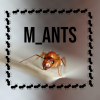How do you familiarize yourself with all ant genuses? I thought a pheidole queen was a fire ant. :facepalm:I want to be less of a newb.
- Formiculture.com
- Forums
- Gallery
- Members
- Member Map
- Chat

How do you familiarize yourself with all ant genuses? I thought a pheidole queen was a fire ant. :facepalm:I want to be less of a newb.
Veromessor pergandei
Veromessor andrei
Crematogaster sp.
Pogonomyrmex cf cali and rugosus
Various Pheidole
C. yogi
Browse around on sites like antweb and antwiki. there's really nothing to it other than doing some research.
I am a noob too lol, Pheidole do look a lot like Solonopsis queens though, a lot of ID's have to do with small details like hairs, thorax shape, petiole shape and number, antennae segments, gaster shape and segments, etc. so you kinda just gotta research the species in your area and look for differences
You don't need to pay attention to small things to get a genus level ID (usually) Look at the body shape. Pheidole are flat, blocky, squared off. Solenopsis are round, oval shaped, smooth.
Get real specimens, make sure they are properly identified to subfamily or genus then pay attention to the genera. If you have your specimens and a good subfamily key you can see the "major" and "delimiting"characters for each subfamily and genus. It takes time and an eye for detail. Good luck!!
Go to the ant, you sluggard; consider its ways and be wise! It has no commander, no overseer or ruler, yet it stores its provisions in summer and gathers its food at harvest. -Proverbs 6: 6-8
My Ant Shop Here I have PPQ-526 permits to ship ants nationwide
Attention Ant-Keepers in South Dakota! Join the SoDak(Society Of Dakotan Ant Keepers)
Pheidole and Solenopsis are very similar especially the queens. There are thousands of ant species ,but they occupy the whole globe. If you live in a northern area you could probably get familiar with the ones in you area in a few hours of google. If you live in a tropical area you could still learn a lot about the more common ones in very little time.
Study, study, study.
Size and color are the best way to determine a genus. I have misidentified many ants over the phone when I do not get the size.
Its almost never good to use color. Size is alright, but many species among a genus or even individuals among a species vary a lot in size.
Color sucks
Color sucks
My Main Journal | My Neivamyrmex Journal | My Ant Adoption | My YouTube
Join the TennesseeAnts Discord Server! https://discord.gg/JbKwPgs
Size and color are the best way to determine a genus. I have misidentified many ants over the phone when I do not get the size.
Not true at all. Not all 5 mm black ants are Formica. Could most certainly be Camponotuts (Myrmentoma) sp. And what about telling apart Lasius and Nylanderia? Generally same size and color. Some Tetramorium and Pheidole look similar. What about Temnothorax and Solenopsis molesta? Here's some more:
Aphaenogaster/Myrmica
Polyergus/Formica
Dorymyrmex/Tapinoma
Ponera/Hypoponera
Acromyrmex/Atta
Prenolepis/Myrmecocystus
These could all be confused by beginners.
Edited by AntsDakota, June 10 2020 - 4:09 PM.
"God made..... all the creatures that move along the ground according to their kinds (including ants). And God saw that it was good. Genesis 1:25 NIV version
Keeping:
Tetramorium immigrans Camponotus vicinus, modoc, novaeboracensis, herculeanus
Formica pallidefulva, argentea Solenopsis molesta
Formica cf. aserva Lasius brevicornis, neoniger
You really just have to familiarize yourself with the ants in your area via trial and error, and eventually you'll get really good at telling them apart. Try browsing Formiculture ID threads, BugGuide, iNaturalist, etc, and post on here if you have any questions. Antwiki/Antmaps is good for trial and error; look at all the different genera in your state and see which ones look like what you have.
Currently keeping:
Tetramorium immigrans, Pogonomyrmex occidentalis
Myrmica punctiventris, Formica subsericea
Formica pallidefulva, Aphaeogaster cf. rudis
Camponotus pennsylvanicus
Camponotus nearcticus
Crematogaster cerasi
Temnothorax ambiguus
Prenolepis imparis
A good tip for telling apart Camponotus and Formica: Camponotus have one hump on the thorax, and Formica have two. Camponotus minors can also be recognized by their somewhat rectangular head, whereas Formica usually have more triangular heads.
Currently keeping:
Tetramorium immigrans, Pogonomyrmex occidentalis
Myrmica punctiventris, Formica subsericea
Formica pallidefulva, Aphaeogaster cf. rudis
Camponotus pennsylvanicus
Camponotus nearcticus
Crematogaster cerasi
Temnothorax ambiguus
Prenolepis imparis
0 members, 1 guests, 0 anonymous users